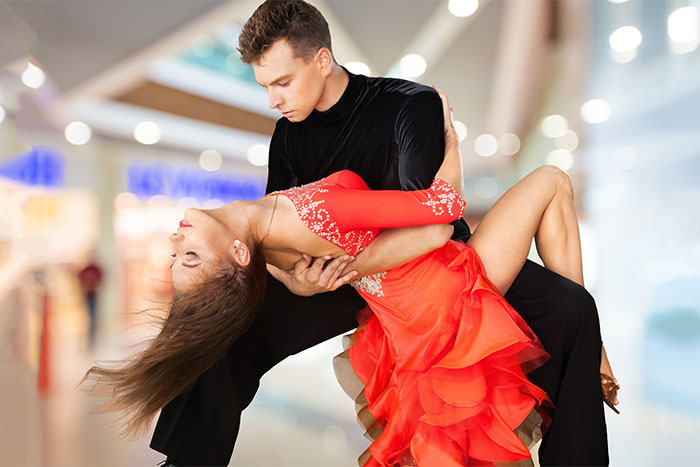The Salsa
The Salsa is a syncretic dance form with origins from Cuba as a major original American meeting point of European and African cultures.Salsa is normally a partner dance, although there are recognized solo forms such as solo dancing “suelta” and “Rueda de Casino” where multiple couples exchange partners in a circle. Salsa can be improvised or performed with a set routine.
There are a few basic steps of Salsa. The most common is the three weight changes (or steps) in each four-beat measure. The beat on which one does not step might contain a tap or kick, or weight transfer may simply continue with the actual step not occurring until the next beat. The option chosen depends upon individual choice and upon the specific style being danced. One of the steps is called a “break,” which involves a change in direction. Different styles of Salsa are often differentiated by the timing of the break step (On Beat “Downbreak on 1″ or Off Beat “Up beat on 2″). After 6 weight changes in 8 beats, the basic step cycle is complete. While dancing, the basic step can be modified significantly as part of the improvisation and stylings of the people dancing.
Music suitable for dancing ranges from about 150 bpm (beats per minute) to around 250 bpm, although most dancing is done to music somewhere between 160–220 bpm. Every Salsa composition involves complex African percussion based around the Clave Rhythm (which has four types), though there can be moments when the clave is hidden for a while, often when quoting Charanga, Changüí and Bomba. The key instrument that provides the core groove of a salsa song is the clave. It is often played with two wooden sticks that are hit together. Every instrument in a Salsa band is either playing with the clave (generally: congas, timbales, piano, tres guitar, bongos, claves (instrument), strings) or playing independent of the clave rhythm (generally: bass, maracas, güiro, cowbell). Melodic components of the music and dancers can choose to be in clave or out of clave at any point. However it is taboo to play or dance to the wrong type of clave rhythm (see salsa music). While dancers can mark the clave rhythm directly, it is more common to do so indirectly (with, for example,
In many styles of Salsa dancing, as a dancer changes weight by stepping, the upper body remains level and nearly unaffected by the weight changes. Caught in the middle are the hips which end up moving quite a bit —- famously known as the “Cuban hip movement.” Perhaps ironically, the Cuban Casino style of Salsa dancing actually has significant amounts of movement above the waist, with up-and-down shoulder movements and shifting of the ribcage.
The arms are used by the “lead” dancer, to communicate or signal the “follower,” either in “open ” or “closed” position. The open position requires the two dancers to hold one or both hands, especially for moves that involve turns, putting arms behind the back, or moving around each other, to name a few examples. In the closed position, the leader puts the right hand on the follower’s back, while the follower puts the left hand on the leader’s shoulder.
In some styles of salsa, such as LA and New York style, the dancers remain in a slot or line (switching places), while in some Latin American styles, such as Cuban style, the dancers circle around each other, sometimes in 3 points.
Additionally, in the original Latin America form, the forward/backward motion of Salsa is done in diagonal or sideways with the 3-step weight change intact.a shoulder movement). This allows the dancing itself to look very fluent as if the rest of the body is just moving untouched with the legs.
Salsa -There are a few basic steps of Salsa. The most common is the three weight changes (or steps) in each four-beat measure. The beat on which one does not step might contain a tap or kick, or weight transfer may simply continue with the actual step not occurring until the next beat. The option chosen depends upon individual choice and upon the specific style being danced. One of the steps is called a “break,” which involves a change in direction. Different styles of Salsa are often differentiated by the timing of the break step (On Beat “Downbreak on 1″ or Off Beat “Up beat on 2″). After 6 weight changes in 8 beats, the basic step cycle is complete. While dancing, the basic step can be modified significantly as part of the improvisation and stylings of the people dancing.In many styles of Salsa dancing, as a dancer changes weight by stepping, the upper body remains level and nearly unaffected by the weight changes. Caught in the middle are the hips which end up moving quite a bit —- famously known as the “Cuban hip movement.” Perhaps ironically, the Cuban Casino style of Salsa dancing actually has significant amounts of movement above the waist, with up-and-down shoulder movements and shifting of the ribcage.The arms are used by the “lead” dancer, to communicate or signal the “follower,” either in “open ” or “closed” position. The open position requires the two dancers to hold one or both hands, especially for moves that involve turns, putting arms behind the back, or moving around each other, to name a few examples. In the closed position, the leader puts the right hand on the follower’s back, while the follower puts the left hand on the leader’s shoulder.In some styles of salsa, such as LA and New York style, the dancers remain in a slot or line (switching places), while in some Latin American styles, such as Cuban style, the dancers circle around each other, sometimes in 3 points.Additionally, in the original Latin America form, the forward/backward motion of Salsa is done in diagonal or sideways with the 3-step weight change intact.
